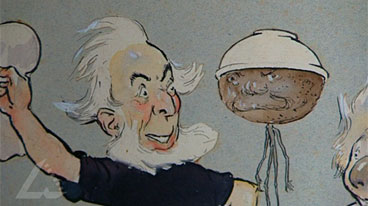Free for educational use
The Magic Pudding Illustrations
Year of production - 2004
Duration - 4min 9sec
Tags - animation, conscription, heritage, media, World War 1, see all tags
On this Page

How to Download the Video Clip
To download a free copy of this Video Clip choose from the options below. These require the free Quicktime Player.
![]() Premium MP4 themagic_pr.mp4 (30.6MB).
Premium MP4 themagic_pr.mp4 (30.6MB).
![]() Broadband MP4 themagic_bb.mp4 (14.4MB), suitable for iPods and computer downloads.
Broadband MP4 themagic_bb.mp4 (14.4MB), suitable for iPods and computer downloads.
The Magic Pudding is an episode of the series National Treasures produced in 2004.
The Magic Pudding
How did bohemian artist Norman Lindsay, famous for painting provocative nudes, end up producing one of Australia’s best-loved children’s books? Cartoonist James Kemsley reveals the legend behind the creation of the first great Australian anti-hero – Albert the never-ending pudding – as Warren Brown takes a look at Lindsay’s original illustrations at the State Library of New South Wales.
National Treasures
Take a road-trip of discovery with the irrepressible Warren Brown – political cartoonist, columnist and history “tragic” – as he reveals a fascinating mix of national treasures drawn from public and private collections across Australia. On its own, each treasure is a priceless snapshot of an historic moment. Together, they illustrate the vitality and uniqueness of the Australian experience.
National Treasures is a Film Australia National Interest Program. Produced with the assistance of the Australian Broadcasting Corporation.
Objective:
Through responding to and composing a wide range of texts in context and through close study of texts, students will develop skills, knowledge and understanding in order to speak, listen, read, write, view and represent.
Outcomes:
Outcome 2: A student uses and critically assesses a range of processes for responding and composing.
Outcome 3: A student selects, uses, describes and explains how different technologies affect and shape meaning.
Outcome 4: A student selects and uses language forms and features, and structures of texts according to different purposes, audiences and contexts, and describes and explains their effects on meaning.
Outcome 7: A student thinks critically and interpretively using information, ideas and increasingly complex arguments to respond to and compose texts in a range of contexts.
Outcome 8: A student investigates the relationships between and among texts.
Outcome 9: A student demonstrates understanding of the ways texts reflect personal and public worlds.
Outcome 10: A student questions, challenges and evaluates cultural assumptions in texts and their effects on meaning.
Outcome 11: A student uses, reflects on, assesses and adapts their individual and collaborative skills for learning with increasing independence and effectiveness.
The Magic Pudding is a children’s book by Norman Lindsay, published in 1918.
It is the adventures of the koala Bunyip Bluegum in search of his missing parents. One of his companions is a magic pudding, which magically renews itself whenever part of it is eaten. A gang of pudding thieves stalk the magic pudding, who is protected by his companions.
When Bunyip Bluegum finds he can no longer live with his uncle’s annoying whiskers, he sets out to find his own place in the world. Rather quickly he meets Sam Sawnoff (a penguin) and Bill Barnacle (a man with a long white beard) and their pudding, Albert. Albert can taste like steak and kidney pie, or plum duff, or any number of things. Albert is rather cranky and his goal in life seems to be to get people to eat as much of him as possible.
The pudding owners are in constant conflict with a couple of pudding thieves, who frequently succeed in stealing Albert for short bursts of time, until they are set upon and beaten up by the Society of Pudding Owners.
The story is a variation on the ‘three wishes’ theme common in fairy stories.
- Understanding the video clip
- What is The Magic Pudding?
- Why was it created?
- Why has it been a popular book?
- How do the illustrations show the skill of the artist Norman Lindsay?
- What is meant by an ‘antihero’?
- Who is an example of an antihero today?
- Why does the character of the Pudding appeal to many people?
- Exploring issues raised in the video clip
The Magic Pudding was published in 1918; it was created as an animated film in 2000.- Allocate a chapter of the book to a small group. The task is to report on it by referring to the story, characters, language, attitudes and values, etc.
- Now watch the animated film and compare these features. Also discuss the filmic elements: voices, animation, music, language and style.
- What are the main strengths and weaknesses of the two different media?
- Write a comparison OR a review.
For more National Treasures information and video clips go to the Investigating National Treasures website


